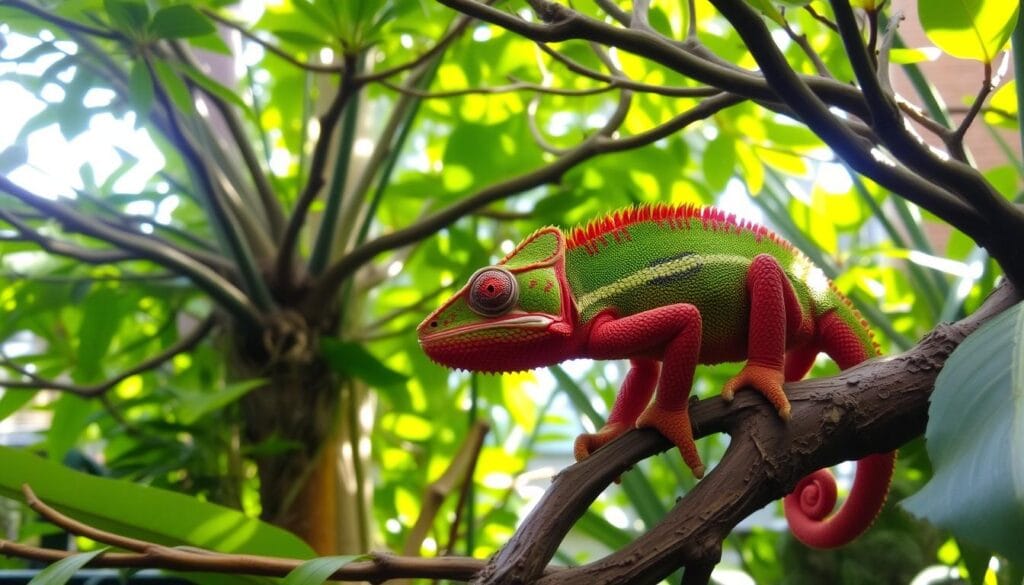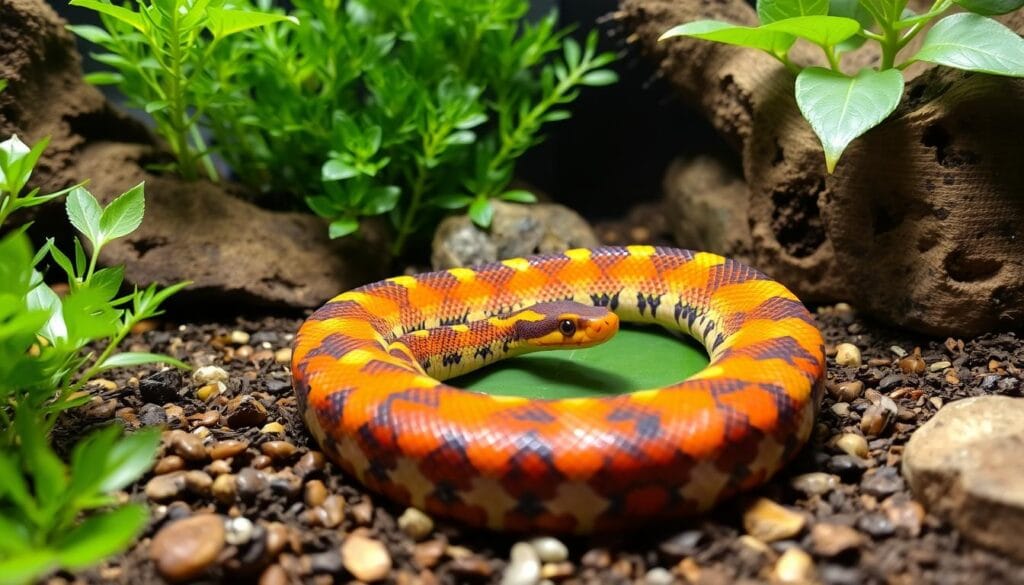When I first saw a bearded dragon at a reptile expo, I was amazed. Its unique charm and gentle nature caught my eye. This moment sparked my interest in reptiles as pets.
The pet market in the USA has changed a lot. Reptiles are now popular pets for many people. They offer a special companionship that’s different from traditional pets.
My exploration into reptile pets showed me a colorful world. Bearded dragons, ball pythons, and leopard geckos are the most loved and Most Popular Pet Reptiles. Each has its own charm that draws reptile lovers in.
Table of Contents
1. Understanding the Appeal of Pet Reptiles
Exotic pet reptiles have won the hearts of many in the United States. About 13% of U.S. homes now have reptiles. These unique animals are becoming more popular as fascinating companions. Their special traits make them stand out from regular pets, attracting reptile lovers.
What Makes Reptiles Great Pets?
Reptiles are great pets for many reasons. They are easier to care for than traditional pets, with 45% of owners choosing them for this reason. Let’s look at what makes these exotic reptiles so appealing:
- Low Maintenance: Need less daily care than dogs or cats
- They are quiet and take up less space
- They can live a long time with dedicated owners
- They offer a unique and educational pet experience
Unique Traits of Reptiles
Understanding the special traits of reptiles is key to caring for them. These creatures add wonder to pet ownership:
| Reptile Species | Average Lifespan | Typical Size |
|---|---|---|
| Bearded Dragon | 10-15 years | Up to 24 inches |
| Leopard Gecko | 10-20 years | 7-11 inches |
| Corn Snake | 15-20 years | 4-6 feet |
Differences Between Reptiles and Traditional Pets
Reptiles are different from traditional pets in many ways. They need specific habitats with the right temperature and lighting. While 58% of reptile owners are families with kids, it’s important to consider their unique needs. Setting up a reptile’s home can cost between $100 to $500, showing they are a big investment in a special pet experience.
2. The Top Choice: Bearded Dragons
Bearded dragons are a top pick for reptile lovers. They are loved in the United States for their unique personalities and easy care. These pets are truly special.
Fun Facts About Bearded Dragons
Bearded dragons are very popular pets. They can grow up to 1-2 feet long. They have some amazing traits:
- Can change color based on temperature and mood
- Named for their distinctive throat pouch that puffs out when threatened
- Highly social and interactive with their owners
Care Requirements
Bearded dragons need special care. They need a varied diet and the right habitat. Here’s what they need:
- Diet includes both insects and vegetables
- Regular calcium supplementation is crucial
- Need consistent handling to maintain socialization
Ideal Environment for Bearded Dragons
Creating the right habitat is key. They need a tank of at least 70 gallons. The tank should have the right temperature and lighting. Proper setup ensures your bearded dragon remains healthy and thrives in captivity.
They like a temperature range of 75-85°F. Basking spots should be 95-105°F. This makes them feel at home and keeps them active.
3. The Versatile Leopard Gecko
Leopard geckos are among the most popular reptile pets. They are great for both new and experienced reptile owners. These pets are loved for their unique looks and easy care.
Why Leopard Geckos Are Popular
Leopard geckos are a favorite among reptile pet lovers for many reasons:
- They are the right size (7-10 inches long)
- They are calm and gentle
- They are easy to care for
- They have cool spotted patterns
Feeding and Habitat Needs
Leopard geckos need the right food and living space. Their diet mainly includes live insects. Here are some feeding tips:
| Age Group | Feeding Frequency | Daily Insect Quantity |
|---|---|---|
| Young Geckos (up to 12 months) | 1-2 times daily | 6-20 insects |
| Adult Geckos | Every other day | 10-15 insects |
Leopard geckos also need a specific living space:
- A terrarium of 10-20 gallons
- Warm temperatures of 85-90°F
- A cooler area at about 75°F
- Humidity levels of 30-40%
Lifespan and Health Considerations
Leopard geckos can live up to 20 years with good care. Important health tips include:
- Regular calcium supplements
- A balanced diet of insects
- Keeping their habitat clean
- Annual vet visits
By knowing their needs, leopard geckos can be wonderful pets for a long time.
4. Chameleons: Beautiful but High Maintenance
Chameleons are a favorite among reptile lovers for their amazing ability to change color. They are among the best pet reptiles for those ready to put in the time and effort for their care.

Unique Characteristics of Chameleons
Chameleons are truly special in the world of reptiles. They have:
- Color-changing skin for communication and mood expression
- Independently moving eyes with 360-degree vision
- Long, sticky tongues that can extend twice their body length
- Specialized feet perfect for gripping branches
Environmental Needs
Chameleons need a lot of attention to their environment. They require specific conditions to thrive:
| Requirement | Specifications |
|---|---|
| Temperature | 70-90°F with distinct temperature gradients |
| Humidity | 50-80% depending on species |
| Enclosure Size | Minimum 4×4 feet with vertical space |
| Lighting | 10 hours of UVB light daily |
Common Health Issues
Chameleons are delicate and can face health problems. Some common issues include:
- Metabolic Bone Disease from calcium deficiencies
- Respiratory infections due to improper humidity
- Stress-related complications
- Nutritional imbalances from inadequate diet
Before getting a chameleon, it’s important to do your research. Make sure you can provide the right care for these amazing reptiles.
5. Ball Pythons: The Beginner-Friendly Snake
Ball pythons are a top pick for new snake lovers. They’re popular because they’re easy to care for and have cool traits.
These snakes are known for being calm and simple to look after. They can grow up to 3-5 feet long, which is big enough for most people.
What to Expect with Ball Pythons
Here’s what you’ll learn about ball pythons:
- They are very calm and gentle.
- They can live for 20-30 years.
- There are over 7,500 colors to choose from.
- They curl up into a ball when scared.
Setup and Habitat
Setting up a good home for your ball python is important. Here’s what you need:
- A tank that’s at least 40 gallons.
- A warm spot for basking at 90-94°F.
- A cooler spot for the day at 78-80°F.
- A cooler spot at night at 75-78°F.
- Humidity should be 50-60%.
Feeding and Care Guidelines
Ball pythons need the right food at the right time. They eat once a week to once a month. Make sure the food is not too big for them. Handling them a lot when they’re young helps them get used to people.
Even though they need special care, ball pythons make great pets. They offer a fun and long-lasting friendship for reptile lovers.
6. Corn Snakes: Colorful Companions
Corn snakes are a favorite among reptile lovers. They are known for their beautiful colors and friendly nature. This makes them a great choice for both new and seasoned snake owners.

Reasons for Their Popularity
There are many reasons why corn snakes are so popular:
- They are calm and easy to handle.
- They come in many vibrant colors.
- They are the right size for most homes.
- They are easy to care for.
Handling and Temperament
Corn snakes are very calm. Gentle handling makes them feel at ease with their owners. They are not usually aggressive, which makes them perfect for anyone interested in reptiles.
Proper Housing Requirements
| Housing Specification | Recommended Details |
|---|---|
| Minimum Enclosure Size | 20 gallons (30 inches long) |
| Temperature Gradient | 85°F (warm side), 75°F (cool side) |
| Humidity Level | 40-50% |
| Typical Adult Length | 3 to 5.5 feet |
Knowing how to care for a corn snake is key to their health and happiness. With the right care, these colorful friends can live over 20 years. This makes them wonderful long-term companions for reptile lovers.
7. Red-Eared Sliders: Iconic Pet Turtles
Red-eared sliders are a favorite among reptile lovers in the United States. They are known for their interesting traits and fun personalities.
Fascinating Facts About Red-Eared Sliders
These turtles have amazing features that make them special:
- Scientific name: Trachemys scripta elegans
- Average lifespan: 20-40 years
- Size range: 6-12 inches
- Native to southeastern United States
Water and Land Needs
Red-eared sliders need a special home that matches their natural habitat. I suggest creating a space with both water and land areas.
| Habitat Requirement | Specification |
|---|---|
| Minimum Tank Size | 50-125 gallons |
| Water Temperature | 75-85°F |
| Basking Area Temperature | 85-95°F |
| Water pH Level | 6.0-8.0 |
Common Myths and Misconceptions
Many people have wrong ideas about these turtles. Here are some myths to clear up:
- They do not stay small forever
- They require significant care commitment
- Not suitable for young children without supervision
With the right care, red-eared sliders can be wonderful pets for reptile fans. They need time and effort to thrive.
8. Anoles: Small but Mighty
Anoles are fascinating creatures that have become popular among reptile enthusiasts. They are one of the best pet reptiles, offering a unique and engaging pet experience. With over 6,000 different lizard species globally, anoles stand out as a captivating option for pet reptile care.
Green anoles are noteworthy among common pet reptiles. These tiny lizards grow to about 8 inches long and live for 3-6 years. They’re very affordable, costing between $5 to $10, making them a great choice for both new and experienced reptile owners.
Types of Anoles You Can Keep
- Green Anole (most common)
- Cuban Brown Anole
- Knight Anole
- Carolina Anole
Care and Habitat Needs
Setting up the perfect habitat is crucial for pet reptile care. For anoles, you’ll need a tropical terrarium with specific environmental requirements:
- Temperature range: 75-85°F
- Humidity level: 60-70%
- UVB lighting
- Climbing branches
- Substrate that retains moisture
Social Behavior of Anoles
Anoles are fascinating creatures with unique characteristics. They can change color slightly and have independently moving eyes, similar to chameleons. While territorial, they can be kept in groups with proper care. The initial setup for an anole habitat typically costs between $100 and $400, with monthly maintenance expenses ranging from $30 to $80.
One of the most intriguing aspects of anoles is their distinctive physical feature – a large red flap they can bulge out beneath their chin. This adds to their charm as one of the most interesting small reptile pets available.
9. Conclusion: Choosing the Right Reptile for You
Choosing the right pet reptile is a big decision. It’s important to know what each species needs. This includes their habitat, diet, and more.
Before picking a reptile, think about your lifestyle and space. Bearded dragons, leopard geckos, and crested geckos are great for beginners. They have different traits that fit various owners and homes.
Do your homework before getting a reptile. Think about the size of their home, temperature needs, and how much food they eat. Also, consider the cost over time. Talking to reptile experts and joining local groups can help a lot.
Having a reptile is a rewarding experience. It takes dedication, patience, and learning. By knowing what your reptile needs, you can give them a happy and healthy life.

